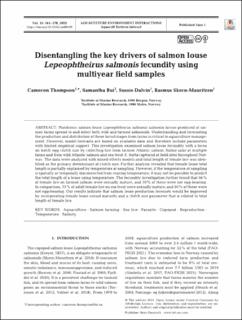| dc.contributor.author | Thompson, Cameron | |
| dc.contributor.author | Bui, Samantha | |
| dc.contributor.author | Dalvin, Sussie Trine | |
| dc.contributor.author | Skern-Mauritzen, Rasmus | |
| dc.date.accessioned | 2023-10-23T12:48:42Z | |
| dc.date.available | 2023-10-23T12:48:42Z | |
| dc.date.created | 2023-07-24T13:46:26Z | |
| dc.date.issued | 2023 | |
| dc.identifier.citation | Aquaculture Environment Interactions. 2023, 15 161-178. | |
| dc.identifier.issn | 1869-215X | |
| dc.identifier.uri | https://hdl.handle.net/11250/3098134 | |
| dc.description.abstract | Planktonic salmon louse Lepeophtheirus salmonis salmonis larvae produced at sal - mon farms spread to and infect both wild and farmed salmonids. Understanding and forecasting the production and distribution of these larval stages from farms is critical to aquaculture management. However, model forecasts are based on available data and therefore include parameters with limited empirical support. This investigation examined salmon louse fecundity with a focus on batch egg clutch size by collecting lice from farmed Atlantic salmon Salmo salar at multiple farms and from wild Atlantic salmon and sea trout S. trutta captured at field sites throughout Norway. The data were analyzed with mixed effects models and total length of female lice was identified as the primary determinant of clutch size. Further analysis revealed that female louse total length is partially explained by temperature at sampling. However, if the temperature at sampling is spatially or temporally disconnected from rearing temperature, it may not be possible to predict the total length of a louse using temperature. The fecundity investigation further found that 66% of female lice on farmed salmon were sexually mature, and 10% of these were not egg-bearing. In comparison, 73% of adult female lice on sea trout were sexually mature, and 40% of these were not egg-bearing. Our results indicate that salmon louse production forecasts would be improved by incorporating female louse sexual maturity and a clutch size parameter that is related to total length of female lice. | |
| dc.language.iso | eng | |
| dc.title | Disentangling the key drivers of salmon louse Lepeophtheirus salmonis fecundity using multiyear field samples | |
| dc.title.alternative | Disentangling the key drivers of salmon louse Lepeophtheirus salmonis fecundity using multiyear field samples | |
| dc.type | Peer reviewed | |
| dc.type | Journal article | |
| dc.description.version | publishedVersion | |
| dc.source.pagenumber | 161-178 | |
| dc.source.volume | 15 | |
| dc.source.journal | Aquaculture Environment Interactions | |
| dc.identifier.doi | 10.3354/AEI00459 | |
| dc.identifier.cristin | 2163252 | |
| dc.relation.project | Havforskningsinstituttet: 14809 | |
| cristin.ispublished | true | |
| cristin.fulltext | original | |
| cristin.qualitycode | 1 | |
